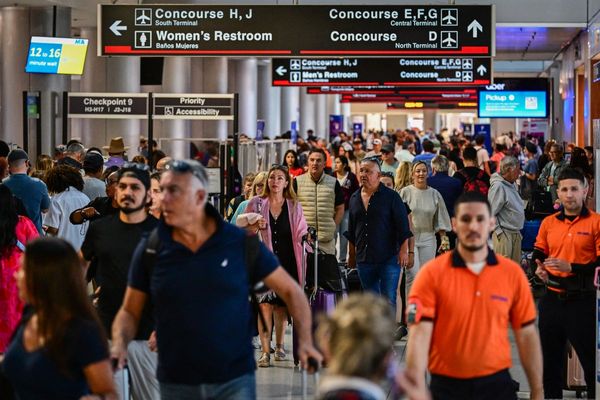Lawyers acting for residents of the two housing estates - the West Kensington and the Gibbs Green - threatened with demolition as part of the gargantuan, widely-opposed but Boris Johnson-backed Earls Court Project redevelopment scheme are considering an appeal against the rejection of their legal challenge to the planning procedures of Hammersmith and Fulham (H&F) and Kensington and Chelsea councils.
The challenge, which received a "substantive hearing" in the High Court in July, disputed the lawfulness of a planning document adopted by the two Conservative-controlled boroughs for guiding the proposed scheme, but a High Court judge dismissed it on Wednesday.
Johnson's close allies at H&F, where the two estates stand, are delighted. Responding to the judge's decision council leader Nick Botterill has declared that he and his administration "now want to put all our efforts into progressing this once-in-a-lifetime scheme."
The council claims that "residents of both estates have been offered some of the best terms ever negotiated in any regeneration scheme in the country." It might be interesting to put this much-repeated assertion to the test.
Meanwhile, Hammersmith MP Andy Slaughter, who represents the residents of the estates for Labour, is unimpressed. "The challenges to this monstrous scheme are just starting, not finishing," he warns. He accuses the council of selling the estates land to its giant developer partner Capco for less than it is worth, of giving an easy ride to a Capco plan that would destroy the Earls Court exhibition centre and require the relocation of a key London underground maintenance facility, and of preparing to force thousands of people to leave their homes to help make way for an invasion of "luxury high-rise, buy-to-leave-empty flats."
I think he might have a point. "This scheme will continue to be fought through the courts and at the local elections next May," Slaughter adds. A decision about appealing against Wednesday's High Court decision is likely to be made in the next couple of days.
Ten reasons why it's wrong
Andy Slaughter's short critique of the Earls Court project is quoted above. Here's are my top ten objections to the scheme.
One: unlike other large redevelopment schemes in London it aims to wholly re-engineer an entire, interlocking neighbourhoods whose core components are functioning and valuable. There are practically no disused buildings, patches of wasteland or failed system-built housing blocks whose passing few would regret. Regeneration schemes should aim to build on what is good and destroy as little as possible. The Earls Court Project wants to do the opposite.
Two: the Earls Court exhibition centre is a London landmark, hallmark and a historically cherished venue. It is central to the area's character and history, vital to the success of a multitude of local small businesses and an asset to the capital. It offers exhibition and conference space in central west London of a size and type that nearby Olympia, also owned by Capco, cannot. The Association of Event Organisers makes a strong case for saving it but this has been ignored - there's more money for developers in expensive residential tower blocks.
Three: the Lillie Bridge maintenance depot is a vital part of the London Underground system and should not to be messed with lightly. Transport for London, in urgent need of money, is understandably in no rush to sell the land it stands on to Capco given that its value looks set to continue rising for some time, but would it be considering moving the depot facilities at all were Boris Johnson, chair of TfL's board, not intent on backing the Earls Court Project in the "opportunity area" he designated? There is also an argument that land in London owned by public bodies should be sold cheaply or even given away to housing providers in return for supplying homes that Londoners on low and middle incomes can afford, especially in the most expensive areas. This option seems not to have been even considered by the Conservative politicians backing Capco's plans.
Four: even residents who favour the Earls Court Project don't consider the West Kensington and Gibbs Green estates to be "sink estates." Alternative proposals for improving them and increasing the amount of housing there were made by the official tenants associations based on a proven community ownership model, but these were rejected by H&F and coalition plans to facilitate such grassroots empowerment were lobbied against by its then leader Stephen Greenhalgh. The powers have since been watered down. Such are the limits of Tory localism.
Five: Hammersmith and Fulham council has gone out of its way to pretend to be putting the interests and involvement of estate residents first but in reality has done all it can to by-pass and ignore the wishes of the majority. In nearby Westminster, another Conservative administration, estate regeneration proposals have been put to formal votes by residents and their outcomes respected. Knowing it would probably lose, H&F has been careful not to extend this option to residents of West Kensington and Gibbs Green.
Six: the amount of additional "affordable" housing in the scheme is pitifully low – barely 11% of the total – even by current London standards and what little is proposed won't be very "affordable" at all, even to part buy or rent. Increasingly the supply of housing of all kinds is one thing, imagining that supplying large quantities of it that is beyond the price range of all but the very affluent and super-rich will match that supply to the spectrum of demand looks fanciful. Hammersmith and Fulham claims to want to help people on middle incomes, but even the tiny number of extra "affordable" homes the project promises look likely to be accessible only to households with incomes well above the London average. This was surely avoidable and is completely unacceptable.
Seven: in line with H&F's opposition to congestion charging the Earls Court Project is designed to facilitate rather than reduce private motor car use. It envisages increasing the number of parking spaces in the redevelopment area by nearly 2000 to over 5000. Even free market urban development theorists consider it environmentally and economically desirable to regulate car use rather than encourage it.
Eight: the Mayor and his Tory allies at H&F and neighbouring Kensington and Chelsea have fallen over themselves to hand the controlling influence over the project area to Capco. The developer commissioned and paid for Sir Terry Farrell's masterplan, secured the omission from the planning applications of a "review mechanism" that might have enabled an increase in the amount of affordable housing, were invited into an "exclusivity agreement" with H&F over the sale of the estates land and pursued a marketing campaign billed as a form of "community engagement" while by-passing the wishes of elected tenants and residents associations.
Nine: higher density home-building, perhaps especially near the centre of London, may be inevitable and even desirable. Yet the cluster of towers Capco wants to construct adjacent to the Empress State Building at almost the same height flies in the face of promises to retain and respect existing streetscapes and contradicts the view, held by many Conservatives, that densities similar to those achieved by high-rise buildings can be matched by the imaginative building of traditional residential streets.
Ten: the project is driven by dogma, prejudice and blind faith; the dogma of hardline radical Conservatism; the prejudice that social housing is inherently a social ill; a blind faith that unconstrained free market economics are the solution to every problem.
Several of the Earls Court Project's ingredients can be found in different forms in other large redevelopment plans all over London, involving at various times Labour and Liberal Democrat as well as Conservative politicians. They include the Elephant and Castle, Nine Elms, Kings Cross, Wards Corner, the Northumberland project centring on Tottenham Hotspur FC, Brent Cross and, of course the Olympic Park and its surroundings along with the re-engineering of housing estates such as Kidbrooke and Woodberry Down.
Each of these has come under attack for various reasons and most have run into trouble of some kind, revealing the shortcomings of the way London does regeneration. The problem is that the policies of successive national governments have helped make that model pretty much the only one available.
That said, other schemes and borough strategies have at least striven - albeit with varying degrees of enthusiasm and mixed results - to see that those local people most in need of improvements in their neighbourhoods and lives derive a decent share of the benefits.
The Earls Court Project could have taken a different form, could have sought to develop the area in a different sense of the word rather than disemboweling it, could perhaps have been a fruitful bottom-up collaboration between boroughs, mayor, TfL, businesses, communities and, yes, the giant private developer. Instead, we have an exclusive alliance of corporate wealth and the state - local, regional and national - deciding it knows best and imposing its will, top-down. This is not how to make a bigger London better.
Update, October 20 2013. Lawyers acting for the Earls Court project's opponents have decided not to appeal against the rejection of their judicial review appeal.







